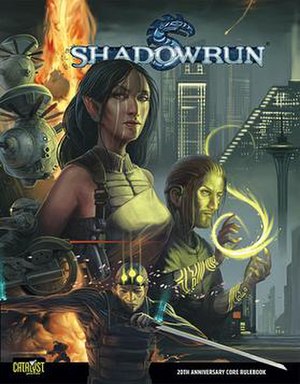So the gang at Catalyst has redesigned Shadowrun and released 5th edition. We managed to get our hands on a PDF copy to look at. But before we get into this review I have to let you know that this is a re-visitation for me of the Shadowrun world. I haven’t played SR since about 1986. I have dabbled with a little bit of the fiction here and there, and I even picked up an almanac or two for reference material. With that being said I asked the powers that be (Jason Hardy) a lot of questions about the changes. I even purchased the 4th ed book as reference material. So you’re going to get the impression of an individual who took a crash course on the two game systems. It’s my hope that you can see how simple the system is.
With all of the above taken into consideration let’s dive right in. The very first thing I noticed was that the table of contents is huge – five pages. Before going any further I jumped right to the back of the book to see if there was an index; my favorite tool in most gaming books. Along the way I discovered an intricate bookmark system built into the PDF. Needless to say I found the layout of the book to be impeccable. The book is riddled with tables that make it easier to use. Did I mention this book is huge!
The art is not quite what I expected. Don’t get me wrong it tells the visual story of Shadowrun very well. I was just expecting something a little darker. I will admit I want prints of every night city scape they have in the book. There is something very alluring about the light pollution.
There is a large amount of fluff in the book. Enough for veteran players to find something new and for new players to be, well, overwhelmed. I’m still working through the fluff. Which is a good thing since I don’t like to ruin the fluff for you. I will tell those of you that don’t already know the background story is this: Shadowrun is a dark world being swallowed by technology far advanced from ours, magic has been reborn, and now races of old walk the earth again. The whole planet is driven by greed that causes a sense of depravity thrusting humanity and all of its kin into desperation.
There are quite a few changes in SR5.
- New Limits on all tests. This is an expansion to the force hit cap in SR4 The new cap is caused by many things in SR5, like gear or attributes.
- Skills have been capped at 12.
- A change to the initiative system. Jason told me this change was made to close the gap between slow Characters and fast Characters. I guess in SR4 a slow Character could wait 2 or 3 turns before getting an action. I never played SR4 but it sounds like it was a needed change.
- The Matrix was rewritten/reworked so it can better reflect other areas of Shadowrun. I really can’t comment much here because I haven’t used the Matrix.
- Character creation went through a major change and introduces the priority system.
- Vehicle chases, combat, spell drain, and gear costs were reworked a little as well.
Those are most of the changes. We are going to spend a good bit of time talking about the character creation system because I have only played two games of SR5.
The new priority system is pretty awesome. It is simple. You use a chart to determine Metatype and special attribute points, skill points, wealth, magic or resonance, and attributes. Beyond the chart you have some karma options and positive and negative qualities. If you have a solid understanding of the descriptions for skills and such you can easily create a character on the fly; in 10 or 15 minutes. I built an orc who is a weapons specialist. She took me about 20 minutes. I used the Street Samurai as the base concept to create her. I can’t tell you how simple this system is!
When creating a character using the priority system they give you some concepts to use as your “class”. They are Spellcaster, Technomancer, Face, Street Samurai, Decker and Rigger. That may seem a little limiting, but those are probably the most famous of the Shadowrun archetypes. These concepts still allow plenty of room for you to create any of the archetypes you wish to play. On top of that the rules still offer the classic archetypes in a template form. For example, you can play a pregenerated weapons specialist. I think if they were to offer every archetype as a base concept they would have overpopulated the priority system. By keeping it simple I believe it is much more appealing.
The hardest part about creating my character was choosing the skills and qualities. That is only because it has been over 20 years since I last played. I spent more time reading the descriptions than I did actually creating the rest of the character.
The system is new to me so I’m going to avoid delving to far into checks and combat I suggest you read these for detail on those game concepts.
http://throatpunchgames.com/2013/07/04/ring-side-report-shadowrun-5th-edition/
What I would like to discuss though is the Game Master advice section of the book, I’ll try not to spoil it too much. First off it is almost a book in itself, nearly 50 pages. Two sections of GM advice are absolutely phenomenal, “Designing a Run” and “Handling a Campaign”.
“Designing a Run”is a step by step guide that GM’s can use to create a Hook, line, and sinker style run. They really focus on making your run more interactive by encouraging the use of handouts, like maps and documents. I have always found that items like this make the game more tangible, which helps the imagination – especially with new players.
The “Handling a Campaign” section is not as in depth as the planning of a run, but it still has great advice. The most important is “Plan to Finish”. I can’t tell you how many times too much ambition gets in the way of a good game. Beyond that one of the better pieces of advice is to plan the character advancement. These are a few simple pieces of advice that can easily go a long way.
Oh another awesome section is the one section on roleplaying NPC’s. It is a great “tutorial” on playing a handful of Shadowrun archetypes. It even has some great tables for random NPC selection. NPC’s are often overlooked in rulebooks, at least I think so. Which is a shame because they are often just as important as the story line.
After reading the Shadowrun 5th ed rues and playing a couple of times I have come to the conclusion that the game has been streamlined for easier play. The simple character creation encourages new players, and returning players to try the system. All of the tables and charts in the book make it a very effective tool for players and GM’s, while the Section on GM advice actively encourages any player to try their hand at telling a story. Shadowrun 5th ed has gone well above and beyond my expectations for the system.




Sorry, the comment form is closed at this time.